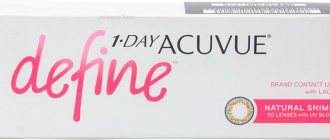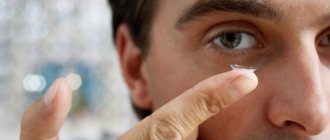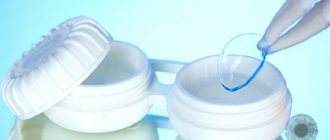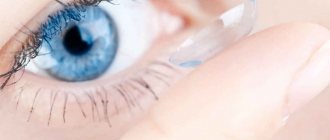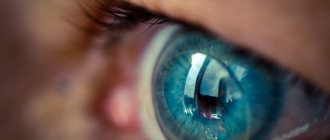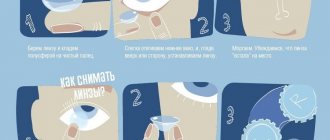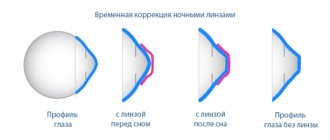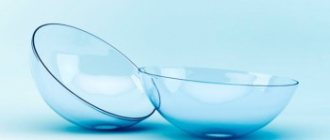Lenses for teenagers: main advantages
Many teenagers want to wear contact lenses. They provide high quality vision and do not limit freedom of movement at all. Contact correction products are convenient when playing sports because they do not compress the bridge of the nose and do not fog up in unfavorable weather conditions. Unlike glasses, they eliminate the appearance of aberrations (distortions) of the image, since they guarantee good quality of peripheral vision. In addition, clear contact lenses are invisible to the eyes and therefore do not attract the attention of others. This is very significant, since the attitude of adolescents towards their own appearance largely determines their self-esteem. The need to wear glasses for farsightedness, myopia and other refractive errors can provoke the development of complexes and self-doubt. Therefore, contact correction devices are the optimal solution to vision problems for schoolchildren, as well as older young people.
Pros of wearing lenses for teenagers:
- Provides high clarity of vision;
- Do not restrict freedom of movement;
- Eliminates image distortion;
- They do not squeeze the bridge of the nose and do not fog up in rain, fog, etc.;
- Allows you to exercise comfortably;
- They do not change their appearance and do not attract the attention of others.
At what age can children wear contact lenses?
Doctors do not consider the age of a child with visual impairment to be a decisive factor. If the child understands the risk associated with non-compliance with the hygiene standards that are required when wearing lenses, then he is ready. As a rule, schoolchildren begin wearing lenses at the age of 14. However, research confirms that with parental help and support, 8-year-old children can successfully use contact lenses.
Your child's doctor will teach you how to use and care for contact lenses correctly. Typically, children have respect and trust in the doctor - then they tend to follow the recommendations received, sometimes even more carefully than adults.
When deciding to purchase contact lenses for your child, do not underestimate his ability to care for them properly. In the course of research, it was found that 8 out of 10 teenagers easily cope with this after 3 months of using lenses. However, young children should be supervised by their parents to minimize the risk of contact lens misuse.
Girls usually show an interest in contact lenses earlier than boys, as they are more concerned about how they look. Boys' interest in contact lenses is most often associated with the desire to engage in active sports and not experience the inconvenience associated with wearing glasses.
Can a teenager wear contact lenses?
Many parents are interested in whether teenagers can wear contact lenses. And this is not surprising, since there are various myths and stereotypes regarding the use of contact correction products. Through experiments, the global community of ophthalmologists has determined that the ideal age to start wearing contact lenses is 14 years of age. At the same time, doctors believe that if a child is conscious of observing hygiene rules when wearing optics, lenses can be used from the age of 8 (under adult supervision). It is undesirable to do this before, since the child is not yet ready to take care of his health on his own. Lenses for a teenager are the best way to correct vision. In this case, the determining factor is an understanding of the need to care for optics and a responsible approach to compliance with operating rules.
Some doubt whether lenses are harmful, since forums often discuss the possibility of inflammatory and infectious processes in the eyes when wearing these optical products.
Ophthalmologists say that the occurrence of complications is often caused by non-compliance with the mode of use, replacement schedule or rules of care for correction products.
In the manufacture of modern optical products, hypoallergenic hydrogel and silicone hydrogel materials are used. They sufficiently transmit oxygen to the cornea and moisturize it well, which minimizes the risk of complications when wearing optics.
At what age can you wear lenses?
- 14 years is the ideal age to start using these optical products;
- 8 years is the acceptable age for wearing lenses if the child understands the need to care for optics.
Benefits of wearing contact lenses as a teenager
According to the study, participants reported improvements in their appearance, increased satisfaction with vision correction and participation in activities, and positive changes in peer perception [1]. The results obtained are consistent with previous studies showing that contact vision correction can improve the quality of life of both children (aged 8 to 11 years) and adolescents (aged 13 to 17 years) [2, 3].
Contact correction can improve the quality of life of adolescents, and research confirms this
In addition to directly improving quality of life, there is compelling evidence that wearing certain contact lenses can slow the progression of myopia in children and adolescents [4]. In such patients, reduction of myopia has a positive effect throughout life [5].
Are colored lenses harmful for a teenager?
Many young people like to experiment with their appearance. Colored contact lenses allow you to change the natural color of your iris and surprise others. The dye is located inside the lens, so it does not come into contact with the external structures of the eye. This eliminates the risk of accidental staining and an allergic reaction. In the pupil area, optical products are transparent. Thanks to this, they do not distort the image. In the production of these products, high-quality materials are used that nourish the eyes with the necessary beneficial components. However, it is recommended to wear such optical products no more than 4-5 hours a day, since they transmit oxygen to the cornea worse than transparent models.
Thus, answering the question of whether colored lenses are harmful to the eyes, we can say that these correction products are safe for the health of the visual organs if the operating rules are followed.
Before purchasing decorative optics, it is advisable to discuss some points with your teenager. It is important that he does not allow friends to wear or try it on, as this could spread the infection. Also, special care should be taken when choosing scleral lenses. Teenagers often use them to create demonic images at parties, carnivals and other entertainment events. Products of this type cover not only the iris, but also the white area of the eye (sclera).
Why are colored lenses safe for teenagers?
- Made from high quality materials;
- The coloring pigment is located inside the lens and does not come into contact with the external structures of the eye;
- In the pupil area, optical products are transparent, which allows you to clearly perceive objects;
- Colored lenses sufficiently moisturize the cornea and supply it with oxygen (when worn continuously for up to 4-5 hours).
Damage to lenses. Contact lenses: pros and cons.
Damage to lenses. In what cases does it manifest itself? What are the advantages and disadvantages of contact lenses? When are lenses harmful to vision? How to select lenses? What are decorative contact lenses? What is the difference between soft and hard contact lenses? What are overnight contact lenses? What are the rules for wearing contact lenses? When was the first contact lens fitted?
Contact lenses
Contact lenses have long ceased to be a curiosity. However, in our country they are used less often than glasses. But in vain. While some minor harms from lenses exist, contact lenses are much more comfortable to wear and offer several significant benefits.
Elena (25 years old) switched to soft contact lenses two years ago and, in general, did not feel any particular harm from the lenses. Previously, the girl wore glasses. “I wasn’t always comfortable with glasses. In the heat, my glasses slipped down onto the tip of my nose, putting pressure on my ears and the bridge of my nose. Inconveniences also arose in the rain, says the girl. “But it was hardest in winter. Every time I entered a room from the cold, the windows instantly fogged up.” After Elena broke her third pair of glasses, she decided to try contact lenses and consulted an ophthalmologist. After a thorough examination, the doctor selected soft contact lenses for her from a special material - hydrogel. The harm caused by lenses made of this material is almost invisible. “I got used to them almost immediately and no longer feel any discomfort,” Elena shares her feelings. “On the contrary, significant advantages have appeared.” The girl made sure that contact lenses, unlike glasses, do not become covered with perspiration, do not limit the viewing angle and do not distort the image. “I feel very free, I see well and I’m not afraid that the lenses will fall and get scratched,” says the girl. “And driving a car has become much more comfortable.”
Indeed, contact lenses “win” compared to glasses. Perhaps their main advantage is natural vision. In addition, contact lenses do not distort the image, offer a full viewing angle, do not become covered in perspiration when the temperature changes in winter, and do not have “dead zones.” This is their significant advantage, and there is practically no harm from lenses.
Decorative contact lenses
Decorative contact lenses allow you to enhance or radically change your eye color. They are more needed for beauty than for vision. Such contact lenses are worn in disco clubs, at proms, or to take photographs for a foreign passport and when traveling abroad. By the way, in France they prefer green lenses, in Spain - curry, in England - yellow. The choice of decorative contact lenses is very large, and there is no harm from lenses of this type when used correctly. Do you want - with a red light, do you want - a zebra or reflective in ultraviolet light. A correctly selected contact lens fits well on the eye and moves with it. Therefore, a person feels at ease and comfortable. The risk of blinking or losing a contact lens during sudden movement or tilt is minimal.
Modern soft contact lenses are made of hydrogel, a substance that absorbs a certain amount of moisture. They are very elastic, do not cause discomfort and are not noticeable on the eye. At the same time, the damage to the lenses is minimal. The likelihood of them falling out or being displaced is negligible. In addition, it happens that glasses interfere with the use of personal protective equipment: masks, spacesuits, helmets. Then you can't do without contact lenses. The list of such professions has long been defined in the United States. Some workers are suitable for glasses, others - contact lenses or laser vision correction. Unfortunately, we do not yet have such an approach. But there is a need for it.
Hard and soft contact lenses
Depending on the material, there are two types of contact lenses - hard and soft. Each type has its own characteristics. Thus, hard contact lenses are more flexible and durable. However, their selection is somewhat more difficult, and the adaptation period lasts longer.
Hard contact lenses are prescribed for certain diseases. For example, when a person has keratoconus. Then the cornea of the eye changes its shape to a cone-shaped one. By the way, this disease occurs quite often. Hard contact lenses are also prescribed for high myopia, astigmatism, and irregular cornea shape. Glasses are ineffective in such cases.
“One of the patients with high grade keratoconus did not want to wear hard contact lenses,” says the doctor. “So he had to buy new glasses every few months due to changes in their prescription.” When the man was getting ready to travel abroad, the ophthalmologist selected hard contact lenses for him. He felt all the benefits and didn’t want to go back to glasses.
“With the help of contact lenses, you can correct almost all defects in the optical system,” continues the doctor. “In particular, the consequences of injuries, operations, albinism (a birth defect when there is not enough pigment and the eye glows red), scars, changes in the shade or color of the eyes.”
Recently, a mother brought a nine-year-old boy to an ophthalmologist. After examining the little patient, the doctor selected hard contact lenses for him. Four years ago, a child had an accident - the boy injured his right eye with a nail. A scar remained at the site of the injury. He wore glasses for several years. However, they do not completely correct the defect: the child’s left eye sees well, but there are problems with the right. As a result of the injury, the boy's cornea changed shape. In this case, only a hard contact lens will do. Getting used to hard contact lenses is quite difficult, especially if it is on one eye. But if there is no other way out and the main thing is that the child has a desire, the adaptation process is easier than for adults.
Among soft contact lenses, the so-called quarter lenses are the leaders. Based on the duration of wear, such lenses are divided into daily, biweekly, quarterly and annual. About 70% of our fellow citizens who are suitable for soft contact lenses prefer quarter ones. They need to be changed every three months.
Another thing is Western European countries, where, despite their income, two-week contact lenses “lead”. It is advisable to remove lenses at night. However, there are different situations in life: a long vacation, a business trip, childbirth, a vacation in the mountains, when there are no necessary conditions for hygiene. In such cases, special silicone hydrogel contact lenses are suitable. They can be used continuously, i.e. without taking it off at night. The maximum period is 30 days. If you have any problems with your contact lenses, you should contact your doctor immediately rather than trying to solve them yourself.
How to choose lenses correctly
You should buy contact lenses at a designated place. They cannot be purchased according to the scheme: come, buy, leave. Selection of contact lenses by a qualified specialist is required. Fitting and assessment of the position on the eye, as well as further dispensary observation of the patient.
If you have a cold, it is better to remove your contact lenses. In some cases, you cannot wear contact lenses, both hard and soft, otherwise the damage to the lenses may be significant. So, it is better to avoid lenses in case of chronic inflammatory diseases: inflammation of the cornea - keratitis or inflammation of the iris - uveitis.
Another contraindication in which lens insertion can make itself felt is an insufficient amount of tear fluid. To determine this, ophthalmologists conduct a test - they insert special strips into the eyes, which after five minutes become damp by a certain number of millimeters. If a person does not have enough tear fluid, but there is an urgent need for contact lenses, moisturizing centers containing artificial tears are added to them.
If a person has a runny nose and elevated body temperature, it is better to wait for recovery and not wear lenses during the illness. If this is neglected, then the harm of the lenses can manifest itself in the fact that the inflammatory process can occur directly in the eye.
As for age, age is not a contraindication to the use of contact lenses. If necessary, they are prescribed even to infants.
You get used to soft contact lenses faster. The main thing when selecting contact lenses is a thorough examination of the patient and an individual approach. It is necessary to take into account everything: the material from which the lenses are made, the type of activity of the patient, his wishes, and, of course, the peculiarities of the structure of the eye. The selection of contact lenses is preceded by a full examination. An ophthalmologist examines visual acuity and refractive power of the eye, measures intraocular pressure, conducts studies of the structures of the organ of vision and its fundus, and also measures the parameters of the cornea to establish the parameters of a contact lens. But that is not all. To determine whether soft contact lenses are suitable for a patient, 15 minutes to half an hour is enough, explains the ophthalmologist. Hard contact lenses take longer to fit. In Soviet times, this could take up to two weeks. Now we are trying to fit it into a day or two: selection, production of contact lenses and installation. After 10 days - for a follow-up examination.
A person wearing contact lenses must adhere to all the conditions that the doctor pays attention to during the first selection, namely, do not neglect the rules of hygiene and make timely replacements. Then there will be no problems with them and the damage of the lenses, as such, will not be felt at all.
Night contact lenses
Instead of surgery - night contact lenses. Day contact lenses are used to correct vision defects, and night contact lenses are used for therapeutic purposes. Today, hard night contact lenses made of a special material - paragon - are often used to treat mild and moderate myopia in children. The child wears them only at night. After a month of use, a wearing regimen is selected for him.
It all depends on the characteristics of the cornea: some patients wear them every night, others - once every two or three nights. The main effect of this therapy is to inhibit the progression of myopia in childhood without surgery. As a result of this procedure, the shape of the cornea changes; the child sees with his own eye. After a month and a half, the desired effect is achieved. This is one hundred percent vision and the absence of myopia.
Rules for wearing contact lenses
- Contact lenses should be stored in special containers (a new pair of lenses - a new container, if desired - frequent replacement).
- You should wash your hands before touching contact lenses.
- You cannot exceed the permissible period of wearing contact lenses (8-14 hours a day), otherwise damage to the lenses can easily occur.
- Every time a person puts on lenses, the lenses need to be changed. solution.
- Once you have your contact lenses in, be careful when using hairspray, deodorants, and aerosol perfumes.
- If you catch a cold or suffer from seasonal allergies, it is better to temporarily replace your lenses with glasses, otherwise the damage from the lenses will not take long to occur.
- If you are always in a smoky room, your contact lenses may change color and lose their properties.
- Choose high-quality cosmetics: mascara should not crumble, and eyeliner should not smear, otherwise, if they come into contact with the lenses, they and your vision may be damaged.
- If you have sensitive eyes, use hypoallergenic cosmetics or special cosmetics for contact lens wearers. First put on your lenses, then do your makeup, first take off your lenses, then remove your makeup.
- If you take a shower, do not expose your face to the flow of water: contact lenses may “float.”
- If you go to the sea, do not dive with your eyes open. Salty seawater can change the structure of your contact lenses, causing them to become washed out.
Interestingly, the first contact lens was glass. It was installed in 1887 on a patient with removed eyelids. The “glass” served him for more than 20 years.
How to choose lenses for a teenager?
To select optical products, a teenager needs to contact an ophthalmologist and undergo a comprehensive examination of the visual system. It is strictly forbidden to choose lenses on your own, even if you have previously worn glasses and know the required diopters. When choosing contact correction means, it is important to consider a number of additional parameters. One of them is the radius of curvature, which is responsible for the fit of the optical product on the eye. If this indicator is greater than the curvature of the cornea, the lens will begin to dangle, which can lead to increased friction, discomfort and accidental loss when turning the head. In turn, if the radius is too small, the optics will compress the cornea, which can provoke hypoxia. Wearing comfort is also influenced by the diameter and centering of the lens on the eye. In addition, it is worth considering parameters such as oxygen permeability and moisture content. They influence the operating mode of the optics. Some products must be removed at night, others can be left on the eyes while sleeping or even worn continuously for several days.
After the examination, the ophthalmologist will draw up a prescription for the purchase of lenses indicating all the necessary parameters.
Things to consider when choosing lenses:
- Required dioptres;
- Design (aspherical, spherical, toric, etc.);
- Diameter, radius of curvature, centering index;
- Material of manufacture (its parameters of oxygen permeability and moisture content);
- Wearing mode (daytime, prolonged, continuous).
- Other parameters.
What are the best lenses for a teenager?
Typically, ophthalmologists prescribe soft contact lenses for teenagers. They provide high clarity of vision, wearing comfort and quick adaptation. It is recommended to use ephemera whenever possible. These optical products are considered the simplest and safest to use, since they do not require maintenance with a solution. They must be disposed of immediately after the first wear. The teenager puts on the optics in the morning, takes them off in the evening and throws them away. We recommend taking a closer look at such popular one-day products as 1-Day Acuvue TruEye and 1-Day Acuvue Moist. The only drawback of these products is the relatively high cost. Therefore, many parents choose scheduled replacement lenses designed to be worn for 14 days or more. Products of this type have a more favorable price than 1-day models, but at the same time they require systematic care. To do this you will need a multifunctional solution and a container.
Popular optical models for routine replacement include two-week Acuvue Oasys with Hydraclear Plus lenses and Air Optix Aqua products (for 1 month).
Teenagers who lead an active lifestyle will benefit from lenses designed for sports. They have an aspherical design, which minimizes image distortion. In addition, these optical products have increased strength and elasticity. We recommend paying attention to the Adria Sport, PureVision 2 and Air Optix Night & Day Aqua models. Doctors advise teenagers with increased sensitivity of the cornea and a tendency to allergies to wear biocompatible lenses. These are revolutionary means of contact correction, which are not perceived by the human body as a foreign body, and therefore have the fastest and simplest adaptation period.
Biocompatible models include: Maxima 55 Comfort Plus, Contact Day 30 Compatic, Proclear 1 Day.
Recommendations for choosing lenses for a teenager:
- Choose soft optical products (made from hydrogel or silicone hydrogel);
- If possible, give preference to one-day ones (they are the simplest and safest to use);
- Pay attention to lenses for sports (if the teenager attends training and leads an active lifestyle);
- When choosing planned replacement models, pay attention to their wearing mode;
- Choose biocompatible optical products (if you are prone to allergies).
How to start using lenses correctly?
First of all, it should be remembered that the teenager's eyes must gradually get used to wearing optical products. During the adaptation period, some unpleasant sensations may be observed, such as pain, burning, dry eyes, etc. In this case, ophthalmologists recommend using special moisturizing drops that reduce friction and increase operating comfort. On the first day, doctors advise wearing lenses no more than 3 hours a day to reduce eye strain. Next, you should gradually increase the time by 1-2 hours. Once it becomes clear that the habituation process is complete, you can wear clear lenses all day.
It is advisable to participate in training, show how to put on and remove optical products, and also observe how the optics are maintained for the first time (when using planned replacement models).
If a teenager does not properly follow the rules of hygiene, it is worth an additional conversation about the importance of disinfecting lenses in order to prevent the occurrence of an inflammatory or infectious process.
We recommend that you familiarize yourself with the wide range of contact correction products on the Ochkov.Net website. From us you can profitably order products from world brands. We guarantee you fast delivery of products to all regions of Russia!
